SCAPES
The collection of images presented here reveals a distinctive approach to black and white landscape photography that transcends conventional documentation. These photographs represent a profound visual exploration of time, texture, atmosphere, and the fundamental essence of both natural and human-altered environments. Through a deliberate technical and aesthetic approach, these landscapes are transformed from mere scenic representations into emotional meditations on the relationship between light, darkness, and the passage of time.
Time Suspended: The Art of Long Exposure
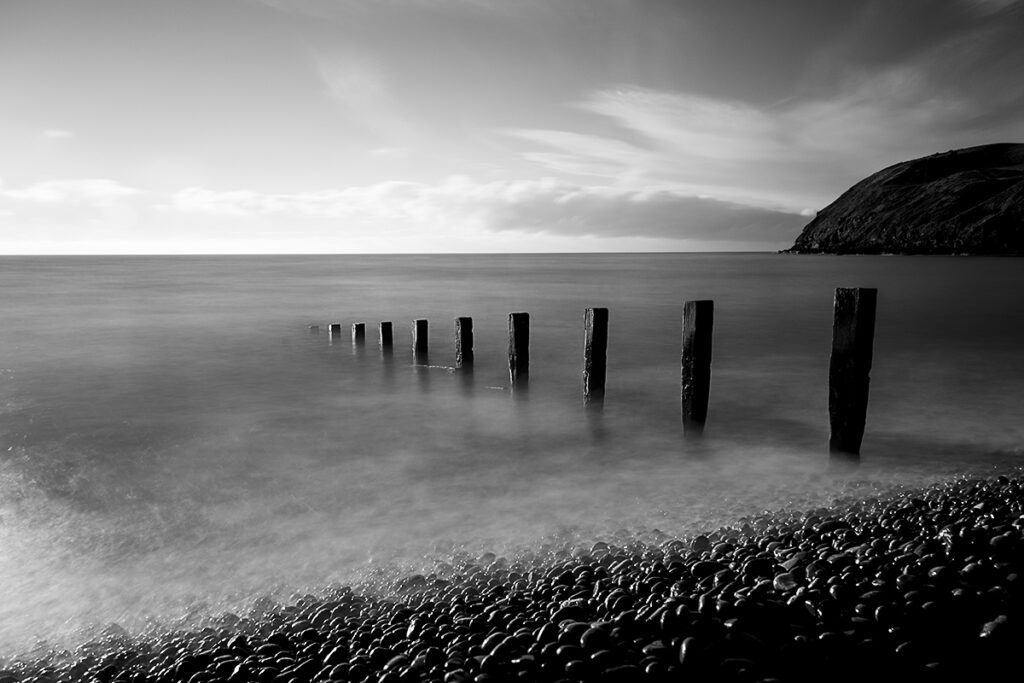
At the heart of these photographs lies the transformative power of long exposure – a technique that fundamentally alters our perception of the world around us. This deliberate technical approach creates the ethereal quality that defines this work, elevating it beyond straightforward landscape representation into something more contemplative and revelatory.
In these images, turbulent seas become misty plains where individual waves dissolve into smooth, dreamlike surfaces. The churning motion of water against rocky shores transforms into a soft, ghostly presence, revealing patterns and relationships invisible to the naked eye. Rushing waterfalls, captured over extended periods, transform into silken veils that appear almost solid in their graceful descent. Clouds, no longer static elements, stretch across skies in dramatic procession, revealing their journey through the frame.
Through extended exposure times—often ranging from several seconds to many minutes—these landscapes reveal a hidden character that exists beyond our ordinary perception. The technique doesn’t simply freeze a moment but instead compresses time itself into a single frame. Water surfaces lose their momentary chaos and become smooth, reflective expanses that mirror the simplicity of form the photographer seeks. Weather systems reveal their gradual movement, creating dramatic sweeps of light and shadow across otherwise static terrain. This technique doesn’t simply capture a landscape but rather documents its passage through time, rendering visible what might otherwise remain unseen.
The patient observation required for long exposure photography is evident in each image. These aren’t quickly captured snapshots but carefully composed scenes that required foresight, technical precision, and a willingness to wait—for the right light, the right tide, the right atmospheric conditions. This meditative approach to photography becomes apparent in the resulting images, which themselves invite similarly patient contemplation from viewers.
Where Light Meets Darkness
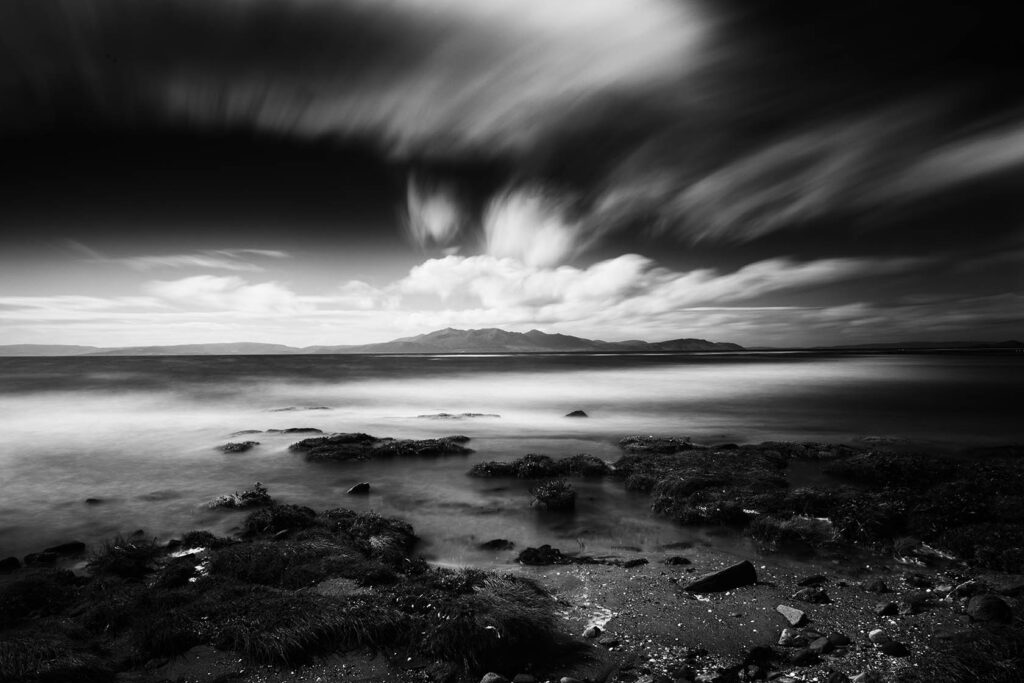
The stark monochromatic treatment of these photographs isn’t merely a stylistic choice but a deliberate decision to distill landscapes to their most fundamental elements. These images aren’t simply representations of landscapes but rather emotional interpretations of them—expressions of how these places feel rather than merely how they appear.
The high contrast black and white treatment strips away the distraction of color, allowing the basic building blocks of visual composition—line, form, texture, and tonality—to command attention. This approach reveals structural elements that might otherwise be overshadowed by colorful details. The architecture of a cliff face, the geometric patterns in beach stones, the delicate branching of bare trees—all become more prominent in the absence of color.
Each image presents a meditative space where light and shadow engage in silent conversation. In some photographs, dramatic rays of light break through cloud formations, creating powerful diagonal lines that guide the eye. In others, subtle gradations of gray create depth and dimension in what might otherwise appear as flat terrain. The interplay between the deepest blacks and the brightest whites creates visual tension that energizes even the most minimal compositions.
The absence of color also removes temporal clues that might anchor an image to a particular season or time of day. Without the warm glow of sunset or the cool tones of morning light, these landscapes exist in a timeless realm. This timelessness allows viewers to engage with the essential character of a place without the distraction of fleeting atmospheric conditions.
The Technical Craft Behind the Vision
Creating these distinctive black and white landscape images requires not only artistic vision but also considerable technical expertise. Long exposure photography demands a thorough understanding of exposure fundamentals, specialized equipment, and often challenging field techniques.
The photographer must master the relationship between aperture, ISO sensitivity, and shutter speed—particularly when exposures may extend to several minutes. Neutral density filters, which reduce the amount of light entering the lens, become essential tools for achieving these extended exposure times, especially in daylight conditions. These specialized filters, often reducing light by 6-10 stops, allow the camera to record the passage of time even in bright conditions.
Stability becomes paramount with such extended exposures. These images require not only tripod support but attention to every detail that might introduce vibration—from cable releases to mirror lock-up mechanisms, from wind protection to stable tripod positioning on uneven terrain. The technical demands extend beyond the moment of capture to the post-processing stage, where raw image data must be carefully interpreted to preserve the photographer’s vision.
The high contrast black and white treatment seen in these images isn’t a simple conversion from color but a nuanced interpretation requiring careful attention to tonal relationships. The photographer must make deliberate decisions about how different colors translate to various shades of gray, emphasizing certain elements while subduing others. The dramatic contrast evident in many of these photographs represents not how a scene literally appeared but rather how it felt to experience it—an emotional truth rather than a documentary one.
Textural Dialogues
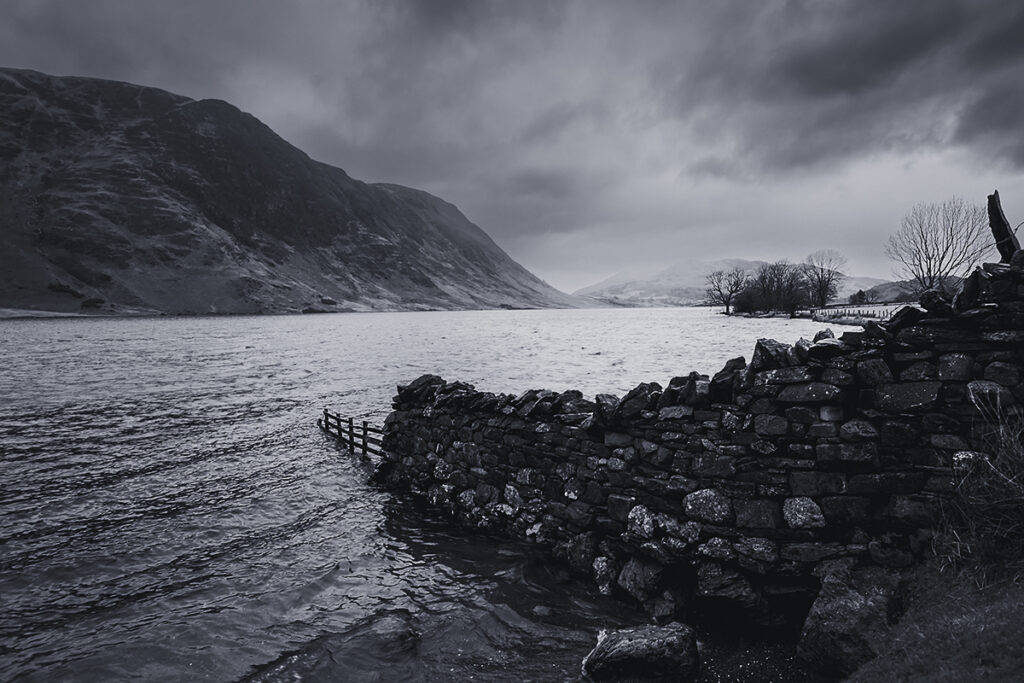
One of the most striking aspects of this collection is its profound sensitivity to texture. These black and white landscapes engage with the tactile dimensions of the natural world, creating visual conversations between contrasting surfaces and materials.
The ancient solidity of cliff faces stands in stark relief against the ephemeral waters that lap at their bases. The weathered surfaces of ruins—human elements slowly returning to nature—contrast with the smooth seas that surround them. The delicate silhouettes of wildlife appear as graphic elements against expansive skies, creating a dialogue between the organic and the atmospheric. These textural contrasts speak to the relationship between permanence and impermanence in our natural world—contrasts made all the more powerful through the patient observation that long exposure requires.
In many images, rocks appear as timeless sentinels, their rough surfaces and distinctive forms emphasized by the stripping away of color. The smooth, silky water surrounding them—rendered this way through long exposure—creates a striking visual contrast that speaks to the geological time scale. Rocks that have stood for thousands or millions of years are juxtaposed with water captured in its momentary flow, creating a visual metaphor for the passage of time itself.
Vegetation, when present, offers another textural dimension. The intricate patterns of tree branches against sky, the soft contours of distant forests, or the delicate stems of coastal plants all provide organic counterpoints to the more mineral aspects of the landscapes. In black and white, the textural qualities of these elements become more pronounced, offering almost tactile experiences through purely visual means.
Emotional Landscapes
These photographs transcend mere geographic documentation to become emotional landscapes—expressions of inner states projected onto the external world. The dramatic skies, isolated subjects, and minimalist compositions evoke contemplation and introspection, creating spaces for viewers to explore their own emotional responses.
The isolation of singular elements—a solitary sheep on a hillside, a lone boat on a mudflat, a single tree against an expansive sky—speaks to themes of solitude without necessarily implying loneliness. There’s a quiet dignity in these isolated subjects, a sense of self-containment that invites reflection on our own relationship with solitude and space.
Weather conditions become emotional metaphors throughout the collection. Brooding storm clouds suggest psychological tension; peaceful, reflective waters evoke calm contemplation; dramatic light breaking through darkness offers moments of transcendence and hope. These aren’t simply meteorological recordings but carefully selected conditions that align with particular emotional states.
Each frame offers a psychological landscape as much as a physical one, inviting viewers to project their own emotional responses onto these stark, beautiful scenes. The high contrast between light and dark areas creates visual drama that heightens emotional engagement, while the subtlety of gray tones in other areas encourages more nuanced responses.
The Poetry of Absence
Perhaps the most distinctive aspect of this photographic approach is its embrace of negative space and minimalism. These images demonstrate that absence can be as powerful as presence, that what is left out can be as significant as what is included.
In many photographs, vast areas of sky or water create breathing room that draws attention to carefully positioned elements within the frame. These expansive, often uniform areas aren’t simply backgrounds but active elements in the composition—spaces that allow featured subjects to resonate more deeply. This approach transforms ordinary scenes into poetic statements about solitude, scale, and our relationship with the natural world.
The minimalist sensibility evident in many of these landscapes reflects an almost Japanese aesthetic sensibility—an appreciation for simplicity, asymmetry, and the beauty of the essential. By reducing scenes to their fundamental elements, the photographer creates visual haiku—concise expressions that suggest far more than they explicitly state.
This poetry of absence invites active participation from viewers, who must fill in the visual spaces with their own imagination and experience. Rather than overwhelming with detail, these images create room for contemplation and personal interpretation. They remind us that what we don’t see can be as important as what we do, that silence can be as meaningful as sound.
A Timeless Perspective
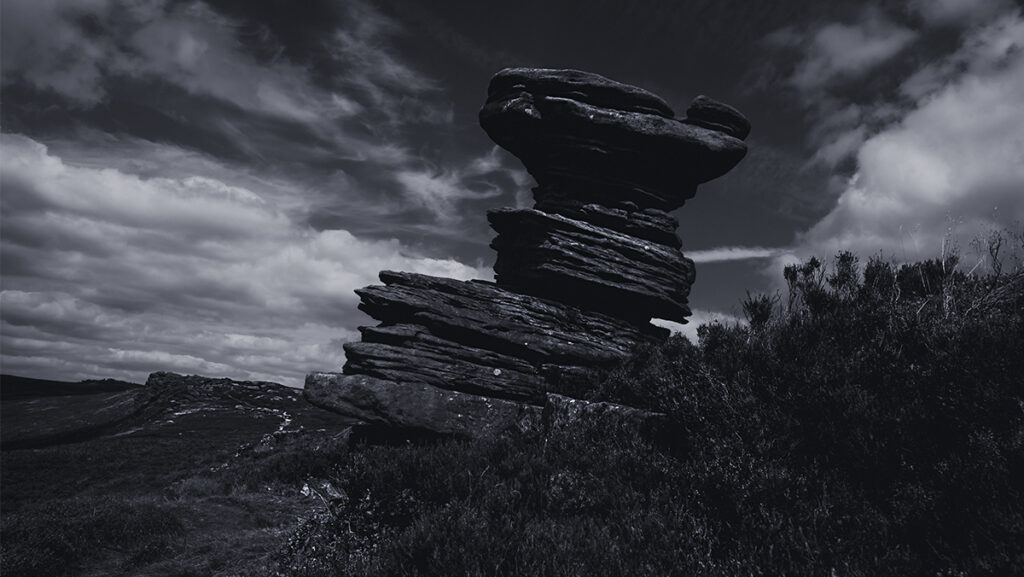
By removing color, embracing dramatic tonal contrasts, and utilizing long exposure to blur the boundaries of moment-to-moment reality, these landscapes exist in a timeless realm. They could belong equally to the past, present, or future—connecting viewers to something eternal in these carefully observed moments.
The removal of specific temporal markers—the golden light of sunset, the particular green of spring foliage, the blue of a summer sky—allows these images to transcend the specific moment of their capture. They speak to something more permanent about these landscapes, something that persists beyond seasonal changes or weather conditions.
This timelessness is further enhanced by the compositional choices, which often eliminate contemporary elements or human presence that might anchor an image to a particular era. When human elements do appear—ancient ruins, traditional stone walls, weathered boats—they tend to be objects that speak to enduring relationships between people and landscapes rather than modern interventions.
The resulting photographs connect viewers not just to these specific locations but to a deeper experience of landscape itself—one that has persisted throughout human history. They remind us that despite our increasingly mediated relationship with the natural world, there remains something profound in the direct experience of dramatic terrain, atmospheric conditions, and the play of light across land and water.
Environmental Consciousness
While these images function primarily as artistic expressions rather than environmental documents, they nevertheless cultivate a particular kind of environmental consciousness. By inviting prolonged engagement with landscapes that might otherwise be quickly glanced at, they encourage a more contemplative relationship with the natural world.
The attention to geological forms, weather patterns, and coastal processes evident in many of these photographs reminds viewers of the dynamic natural systems that shape our world—systems that operate on timescales far beyond human experience. This perspective can foster a humility about our place in these larger systems and a respect for the processes that have shaped these landscapes over millennia.
The minimalist approach also serves to strip away visual noise that might distract from the essential character of these places. In doing so, it allows viewers to reconnect with something fundamental about these environments—something that might be overlooked in more literal or colorful representations. This renewed attention to the essence of place can nurture a deeper environmental appreciation based not on spectacular beauty alone but on a more nuanced understanding of landscape character.
Influences and Traditions
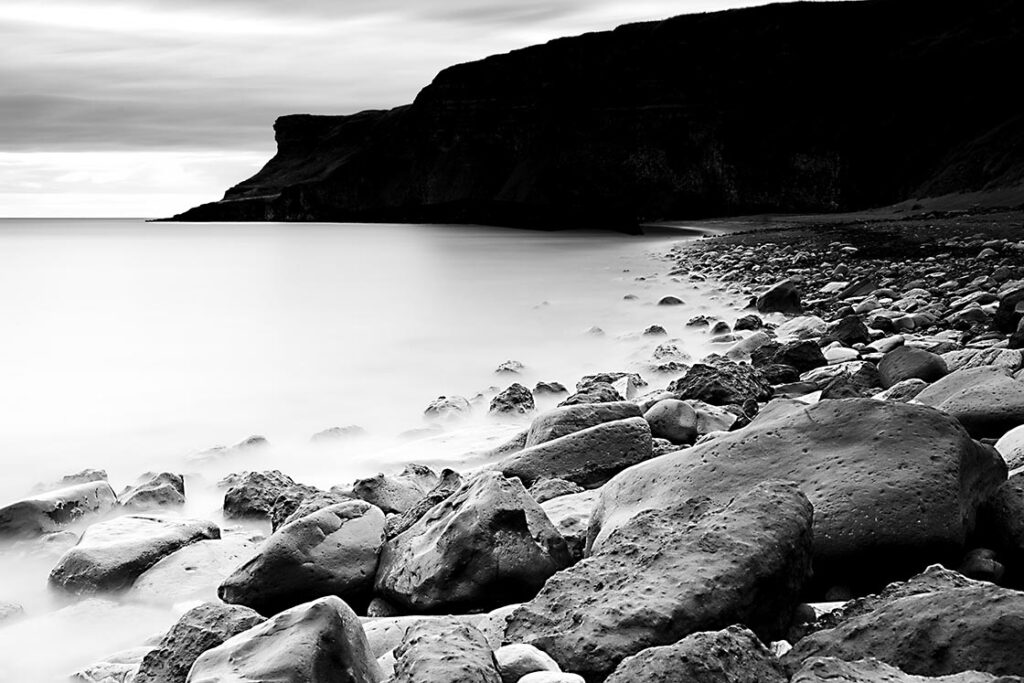
While distinctly contemporary in execution, these black and white landscape photographs exist within rich photographic traditions. They echo the work of masters like Ansel Adams, whose dramatic black and white landscapes of the American West similarly employed technical precision in service of emotional expression. They recall the contemplative coastal studies of Michael Kenna, whose minimalist long exposures transformed ordinary scenes into meditative visual poems.
The influence of traditional Japanese aesthetics—with its appreciation for asymmetry, simplicity, and suggestion rather than statement—is evident throughout the collection. So too is the legacy of abstract expressionist painting, with its emphasis on emotional truth rather than literal representation. These photographs demonstrate how contemporary landscape photography can honor these traditions while finding new expressions relevant to our current moment.
The work also shows awareness of contemporary practitioners who have pushed the boundaries of black and white landscape photography. The dramatic contrasts recall the work of photographers like Sebastião Salgado, while the minimalist sensibility connects to the tradition of photographers like Hiroshi Sugimoto, whose seascapes similarly reduce the world to essential elements.
A Unique Visual Voice
What ultimately distinguishes this collection is its consistent and distinctive visual voice. Despite the variety of subjects—from coastal scenes to mountain vistas, from architectural elements to wildlife silhouettes—a unified sensibility pervades the work. This coherence suggests not just technical mastery but a clear artistic vision—a particular way of seeing and responding to the world.
The collection speaks to those who seek photography that goes beyond the decorative or documentary, offering instead a contemplative visual experience that lingers in the mind long after viewing. These aren’t images for quick consumption but invitations to slow down, to look more deeply, and to reconnect with both external landscapes and internal emotional terrain.
In an era of increasingly rapid image consumption, this work stands as a reminder of the power of patient observation and thoughtful visual expression. It demonstrates how the seemingly simple choice to render landscapes in black and white can open unexpected perspectives and create profound visual experiences.
Follow on Instagram for more explorations of these moody, minimalist black and white landscape visions captured through the revealing lens of long exposure.


